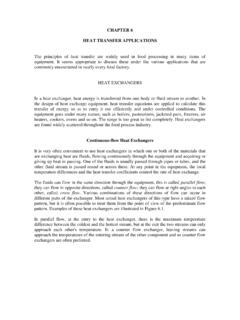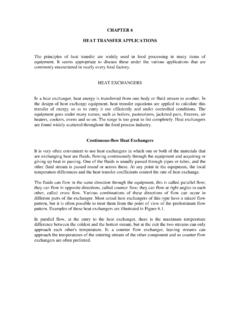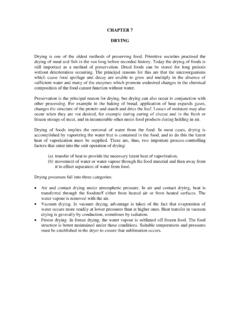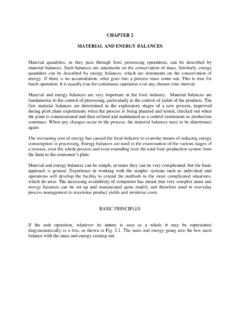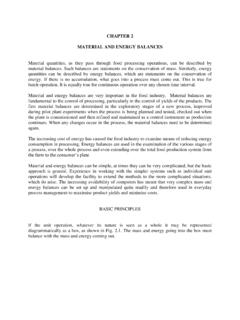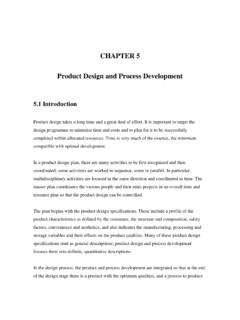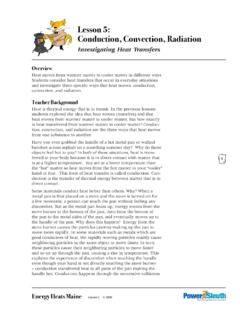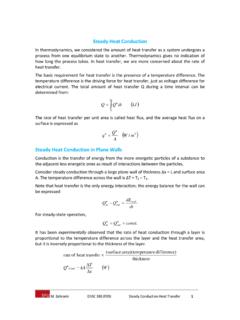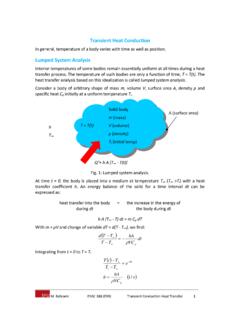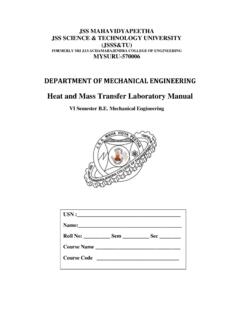Transcription of CHAPTER 5 HEAT TRANSFER THEORY - NZIFST
1 CHAPTER 5 heat TRANSFER THEORY heat TRANSFER is an operation that occurs repeatedly in the food industry. Whether it is called cooking, baking, drying, sterilizing or freezing, heat TRANSFER is part of the processing of almost every food. An understanding of the principles that govern heat TRANSFER is essential to an understanding of food processing. heat TRANSFER is a dynamic process in which heat is transferred spontaneously from one body to another cooler body. The rate of heat TRANSFER depends upon the differences in temperature between the bodies, the greater the difference in temperature, the greater the rate of heat TRANSFER . Temperature difference between the source of heat and the receiver of heat is therefore the driving force in heat TRANSFER . An increase in the temperature difference increases the driving force and therefore increases the rate of heat TRANSFER .
2 The heat passing from one body to another travels through some medium which in general offers resistance to the heat flow. Both these factors, the temperature difference and the resistance to heat flow, affect the rate of heat TRANSFER . As with other rate processes, these factors are connected by the general equation: rate of TRANSFER = driving force / resistance For heat TRANSFER : rate of heat TRANSFER = temperature difference/ heat flow resistance of medium During processing, temperatures may change and therefore the rate of heat TRANSFER will change. This is called unsteady-state heat TRANSFER , in contrast to steady-state heat TRANSFER when the temperatures do not change. An example of unsteady-state heat TRANSFER is the heating and cooling of cans in a retort to sterilize the contents. Unsteady-state heat TRANSFER is more complex since an additional variable, time, enters into the rate equations.
3 heat can be transferred in three ways: by conduction , by radiation and by convection. In conduction , the molecular energy is directly exchanged, from the hotter to the cooler regions, the molecules with greater energy communicating some of this energy to neighbouring molecules with less energy. An example of conduction is the heat TRANSFER through the solid walls of a refrigerated store. Radiation is the TRANSFER of heat energy by electromagnetic waves, which TRANSFER heat from one body to another, in the same way as electromagnetic light waves TRANSFER light energy. An example of radiant heat TRANSFER is when a foodstuff is passed below a bank of electric resistance heaters that are red-hot. Convection is the TRANSFER of heat by the movement of groups of molecules in a fluid. The groups of molecules may be moved by either density changes or by forced motion of the fluid.
4 An example of convection heating is cooking in a jacketed pan: without a stirrer, density changes cause heat TRANSFER by natural convection; with a stirrer, the convection is forced. In general, heat is transferred in solids by conduction , in fluids by conduction and convection. heat TRANSFER by radiation occurs through open space, can often be neglected, and is most significant when temperature differences are substantial. In practice, the three types of heat TRANSFER may occur together. For calculations it is often best to consider the mechanisms separately, and then to combine them where necessary. heat conduction In the case of heat conduction , the equation, rate = driving force/resistance, can be applied directly. The driving force is the temperature difference per unit length of heat - TRANSFER path, also known as the temperature gradient.
5 Instead of resistance to heat flow, its reciprocal called the conductance is used. This changes the form of the general equation to: rate of heat TRANSFER = driving force x conductance, that is: dQ/dt = k A dT/dx ( ) where dQ/dt is the rate of heat TRANSFER , the quantity of heat energy transferred per unit of time, A is the area of cross-section of the heat flow path, dT/dx is the temperature gradient, that is the rate of change of temperature per unit length of path, and k is the thermal conductivity of the medium. Notice the distinction between thermal conductance, which relates to the actual thickness of a given material (k/x) and thermal conductivity, which relates only to unit thickness. The units of k, the thermal conductivity, can be found from eqn. ( ) by transposing the terms k = dQ/dt x 1/A x 1/(dT/dx) = Js-1 x m-2 x l/(oC m-1) = Jm-1s-1 oC-1 Equation ( ) is known as the Fourier equation for heat conduction .
6 Note: heat flows from a hotter to a colder body that is in the direction of the negative temperature gradient. Thus a minus sign should appear in the Fourier equation. However, in simple problems the direction of heat flow is obvious and the minus sign is considered to be confusing rather than helpful, so it has not been used. Thermal Conductivity On the basis of eqn. ( ) thermal conductivities of materials can be measured. Thermal conductivity does change slightly with temperature, but in many applications it can be regarded as a constant for a given material. Thermal conductivities are given in Appendices 3,4,5,6, which give physical properties of many materials used in the food industry. In general, metals have a high thermal conductivity, in the region 50-400 Jm-1s 1 oC-1. Most foodstuffs contain a high proportion of water and as the thermal conductivity of water is about Jm-1s-1 oC-1 above 0oC, thermal conductivities of foods are in the range Jm-1s 1 oC-1.
7 Ice has a substantially higher thermal conductivity than water, about Jm-1s 1 oC-1. The thermal conductivity of frozen foods is, therefore, higher than foods at normal temperatures. Most dense non-metallic materials have thermal conductivities of Jm-1s-1 oC-1. Insulating materials, such as those used in walls of cold stores, approximate closely to the conductivity of gases as they are made from non-metallic materials enclosing small bubbles of gas or air. The conductivity of air is Jm-1s-1 oC-1 at 0oC, and insulating materials such as foamed plastics, cork and expanded rubber are in the range - Jm-1s-1 oC-1. Some of the new in foamed plastic materials have thermal conductivities as low as Jm-1s-1 oC-1. When using published tables of data, the units should be carefully checked. Mixed units, con-venient for particular applications, are sometimes used and they may need to be converted.
8 conduction through a Slab If a slab of material, as shown in Fig. , has two faces at different temperatures T1 and T2 heat will flow from the face at the higher temperature T1 to the other face at the lower temperature T2. The rate of heat TRANSFER is given by Fourier's equation: dQ/dt = kA dT/dx Under steady temperature conditions dQ/dt = constant, which may be called q: and so q = kA dT/dx but dT/dx, the rate of change of temperature per unit length of path, is given by (T1 - T2 )/x where x is the thickness of the slab, so q = kA(T1 - T2)/x or q = kA T/x = (k/x) A T ( ) This may be regarded as the basic equation for simple heat conduction . It can be used to calculate the rate of heat TRANSFER through a uniform wall if the temperature difference across it and the thermal conductivity of the wall material are known. Figure heat conduction through a slab EXAMPLE Rate of heat TRANSFER in cork A cork slab 10cm thick has one face at 12oC and the other face at 21oC.
9 If the mean thermal conductivity of cork in this temperature range is Jm-1s-1 oC-1, what is the rate of heat TRANSFER through 1 m2 of wall? T1 = 21oC T2 = -12oC T = 33oC A = 1m2 k = Jm-1s-1 oC-1 x = m q = x 1 x 33 = Js-1 heat Conductances In tables of properties of insulating materials, heat conductances are sometimes used instead of thermal conductivities. The heat conductance is the quantity of heat that will pass in unit time, through unit area of a specified thickness of material, under unit temperature difference. For a thickness x of material with a thermal conductivity of k in Jm-1s-1 oC-1, the conductance is k/x = C and the units of conductance are Jm-2s-1 oC-1. heat conductance = C = k/x. heat Conductances in Series Frequently in heat conduction , heat passes through several consecutive layers of different materials.
10 For example, in a cold store wall, heat might pass through brick, plaster, wood and cork. In this case, eqn. ( ) can be applied to each layer. This is illustrated in Fig. Figure heat conductances in series In the steady state, the same quantity of heat per unit time must pass through each layer. q = A1 T1 k1 /x1 = A2 T2 k2 /x2 = A3 T3 k3 /x3 = .. If the areas are the same, A1 = A2 = A3 = .. = A q = A T1 k1 /x1 = A T2 k2 /x2 = A T3 k3 /x3 = .. So A T1 = q(x1/k1) and A T2 = q(x2/k2) and A T3 = q(x3/k3).. A T1 + A T2 + A T3 + .. = q(x1/k1) + q(x2 /k2) +q(x3/k3) + .. A( T1 + T2 + T3 + ..) = q(x1/k1 + x2/k2 +x3/k3 + ..) The sum of the temperature differences over each layer is equal to the difference in temperature of the two outside surfaces of the complete system, T1 + T2 + T3 + .. = T and since k1/x1 is equal to the conductance of the material in the first layer, C1, and k2/x2 is equal to the conductance of the material in the second layer C2, x1/k1 + x2/k2 + x3/k3 +.
